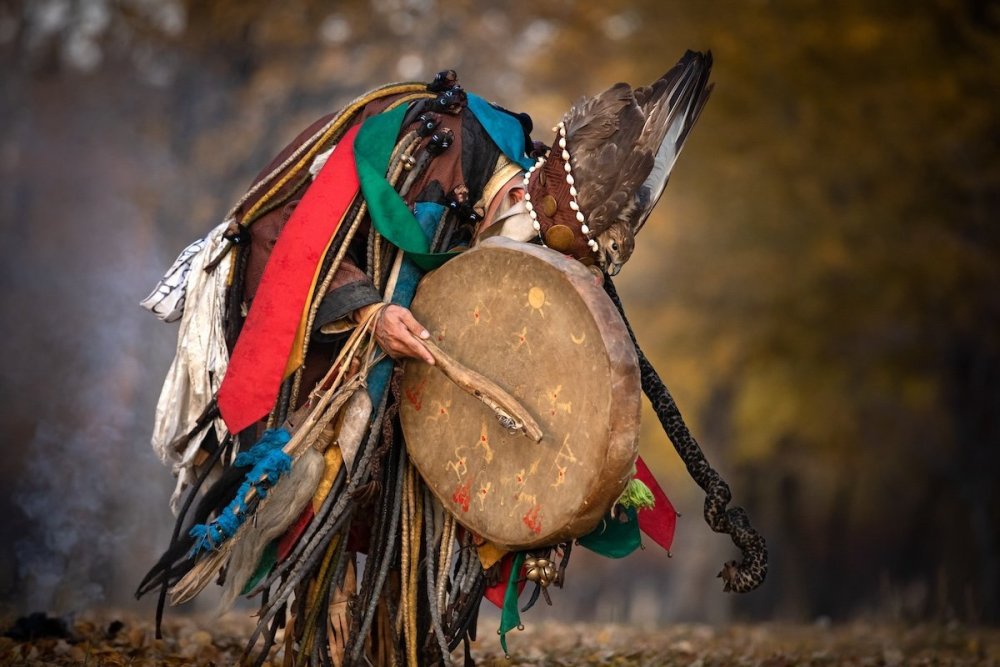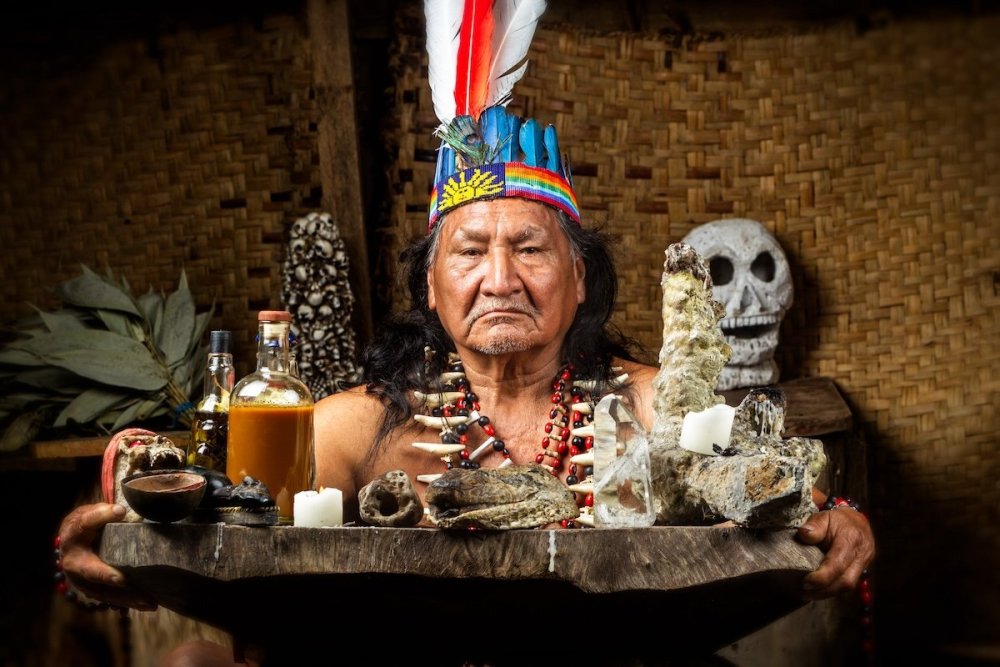Shamanism is an ancient spiritual practice that is often misunderstood. Writer and spiritual seeker Rhianna Quanstrom debunks some of the myths about shamanism, explaining what a shaman does exactly and why their help is called upon.
Shamanism is an ancient spiritual modality still used today. It is both a practice and a way of life; it is a doing and a being.
While it is an ancient tradition, shamanism has evolved with humanity and remains relevant in today’s society. By practicing shamanism, anyone can experience a deeper connection to their spirituality, nature, and the world at large.
Even though it’s still practiced today, shamanism is not widely known or well understood. Because of this, we’ll explore the basics of shamanism and address some common questions, including what shamanism is and what a shaman does.
So, What is Shamanism?
Shamanism is a method of entering an altered state of consciousness to connect with the spirit world. This is often done to facilitate healing and change in the physical world. Through visualization and meditation, one can take a shamanic journey to the “unseen world.” In that space, one can meet with their helping spirits to receive guidance or healing.
Because the shamanic journey is a personal experience, shamanism is a spiritual practice, not a religion. Religion focuses on belief, doctrine, tradition, and ritual. While shamanism has some of these components, it is based on a direct, personal connection to the spirit world rather than worship of a specific deity or adherence to a formal set of religious principles.

Shamanic drumming often is part of a ritual
In fact, it predates religion and is often considered the foundation for all modern spiritual traditions. Every culture has shamanic spiritual roots, and many Indigenous communities still practice traditional forms of shamanism today.
Because shamanism is found across the globe, there are cultural differences in how it is practiced. However, some core values and practices are universally shared. For instance, there is a fundamental belief in two realms or dimensions of reality: the seen and the unseen. The seen world is normal “waking” reality as we know it. The “unseen” world lies just beyond our everyday consciousness and is where spirit dwells.
RELATED:
- Ayahusca Company Retreat: Spirituality At Work
- What is the Peyote Cactus and Is It Legal?
- What Is a Lightworker and What Do They Do Exactly?
Across cultures, shamanism emphasizes respect for and connection to the natural world: a belief that we are all interconnected in the web of life. As such, all of nature – the elements, plants, animals, and ecosystems – is deeply honored and seen as sacred and sentient.
What is a Shaman?
“Shaman” is a term that is often used inappropriately in modern contexts. This can lead to confusion and curiosity about what a shaman is. Practicing shamanism and being a shaman are two different things. While anyone can practice shamanic techniques, not everyone is called to be a shaman or shamanic practitioner.
Answering the question, “What is a shaman?” can be difficult, as there are no universal requirements or prerequisites. Authors and shamanic practitioners Sandra Ingerman and Hank Wesselman claimed in their 2010 book Awakening to the Spirit World that the term “shaman” originates from the Evenki people, a Tungusic tribe in Siberia.
The word has been adopted into the English language to describe members of Indigenous cultures who perform a shamanic role in their communities and to describe modern shamanic practitioners.
“Shamanism is a method of entering an altered state of consciousness to connect with the spirit world. This is often done to facilitate healing and change in the physical world.”
What a shaman does is act as an intermediary between the seen and unseen worlds. A shamanic practitioner typically does not claim the role; rather, they are initiated or called to it.
Traditionally, shamans are initiated into the path through a life-altering experience, such as a near-death event, severe or chronic illness, or extreme psychological distress. They are seen as “wounded healers” – by overcoming intense challenges, they gain wisdom, compassion, healing knowledge, and a deeper connection to Spirit.
Additionally, shamans have a gift for easily entering altered states of consciousness and navigating the unseen realm. According to Ingerman and Wesselman, “In shamanic cultures, the word 'shaman' has come to mean 'the one who sees in the dark' or 'the one who knows.’”
What Does a Shaman Do?
It’s clear that a shaman plays an important role in their community, but what does a shaman do, exactly? A shaman takes on many roles, but they are predominantly healers, spiritual guides, and ceremonial leaders.
A shaman enters the unseen world and communes with helping spirits on behalf of an individual or their community. This role is deeply honored and requires significant responsibility, humility, compassion, and maturity.

A shamanic Ayahuasca ceremony in Ecuador's Amazonia
In modern times, if you were to ask, “What does a shaman do?” you might receive a list of services that looks like this:
- Soul retrieval Returning lost parts of yourself from traumatic experiences or past lives
- Energy removal Releasing energy that is not yours or no longer serves you
- Power retrieval Reclaiming your power and authentic light
- Ancestral healing Clearing what no longer serves from your ancestral line
- Energy healing Receiving loving and healing energy to address physical, emotional, mental, or spiritual wounds
- Space clearing Inviting a shaman into your house or work space to remove harmful energies
To do this work, a shaman enters a trance state, allowing them to traverse the imaginal – or unseen – realms. In shamanism, dis-ease or dis-comfort is believed to originate in the spirit realm. By addressing or extracting the imbalance in the spirit, or unseen realm, the individual receives healing in the physical realm.
Why Do People Use Shamans?
In Indigenous cultures, it is normal to visit a shaman for health concerns and spiritual guidance. In Western societies, however, it is much less common to seek out a shaman for healing or support.
RELATED:
- What is Huachuma, the San Pedro Cactus?
- Non Duality: What it Is, What it Isn't, and Basic Teachings
- What is Ego Death? Meaning, Symptoms, and Causes
People often turn to a shamanic practitioner when other health modalities have not provided the results they seek. It is sometimes seen as a last resort, mainly because it is not widely recognized in modern culture. This may change in the future as more people look for alternative health options that honor the body, mind, and spirit.
What Evidence is There That Shamanism Works?
Research has only recently begun to investigate the efficacy of shamanic healing. This is exciting, as science is starting to bridge the gap between traditional, ancestral knowledge and modern understanding.
Before we dive into the scientific evidence, it’s important to note that shamanism has existed for more than 50,000 years (Ingerman & Wesselman, 2010). It has stood the test of time and is still practiced today, which is considerable evidence of its healing potential.
“What a shaman does is act as an intermediary between the seen and unseen worlds. A shamanic practitioner typically does not claim the role; rather, they are initiated or called to it.”
Now to the scholarly evidence. One study published in the International Journal of Transpersonal Studies investigated the psychological effects of shamanism on 27 participants who had no prior experience with shamanic healing. After the four-month trial, participants experienced, among other things:
- An increase in self-awareness, confidence, and the desire to live
- Trauma resolution (including the resurfacing of forgotten memories and gaining a new perspective)
- Emotional healing
- A decrease in allergies and daily suffering
Another study from the National Library of Medicine demonstrated that shamanic healing significantly reduced pain and improved overall well-being in female participants with Temporomandibular Joint Disorders (TMDs).

Fire ceremonies are a core ritual in shamanic work
And yet another study highlighted the fascinating neurological effects produced by consistent drumming or rattling, which is what a shaman does to enter the trance state. Researchers found (among other things) that the effects on the brain were similar to those produced by psychedelics such as MDMA and psilocybin.
Takeaway: What is Shamanism?
Shamanism is an ancient spiritual practice that can potentially support our modern needs. It encourages healing on the energetic and spiritual levels, which then ripple out into our physical reality. It is accessible to everyone; one does not need to be a shaman to practice shamanic techniques.
That said, modern shamanic practitioners are becoming more common in Western societies. They can help guide you on your healing journey and provide tools for you to use in your own time and in your own way.
Most importantly, shamanism is about connecting to your inner wisdom and light. In this way, it is a personal spiritual practice that can bring greater peace, clarity, and fulfilment to one’s life. ●
Images: shutterstock/Kertu, shutterstock/Ammit Jack, shutterstock/Zolotarevs
happiness.com | The fine art of being: learn, practise, share
Are you a happiness.com member yet? Sign up for free to:
■ enjoy our happiness magazine with practical life tips
■ share and support in our happiness forum
■ self-develop with free online classes in our Academy
Written by Rhianna Quanstrom
 Rhianna Quanstrom is a freelance writer, herbalist, and spiritual seeker with a passion for nature-based healing and sacred wisdom. Her writing draws from years of experience with meditation, shamanic practices, plant medicine, dream work, and the reclamation of the Sacred Feminine. Discover more of her writing and poetry on her Mystic Love Substack.
Rhianna Quanstrom is a freelance writer, herbalist, and spiritual seeker with a passion for nature-based healing and sacred wisdom. Her writing draws from years of experience with meditation, shamanic practices, plant medicine, dream work, and the reclamation of the Sacred Feminine. Discover more of her writing and poetry on her Mystic Love Substack.


Join the conversation
You are posting as a guest. If you have an account, sign in now to post with your account.
There are no comments to display.